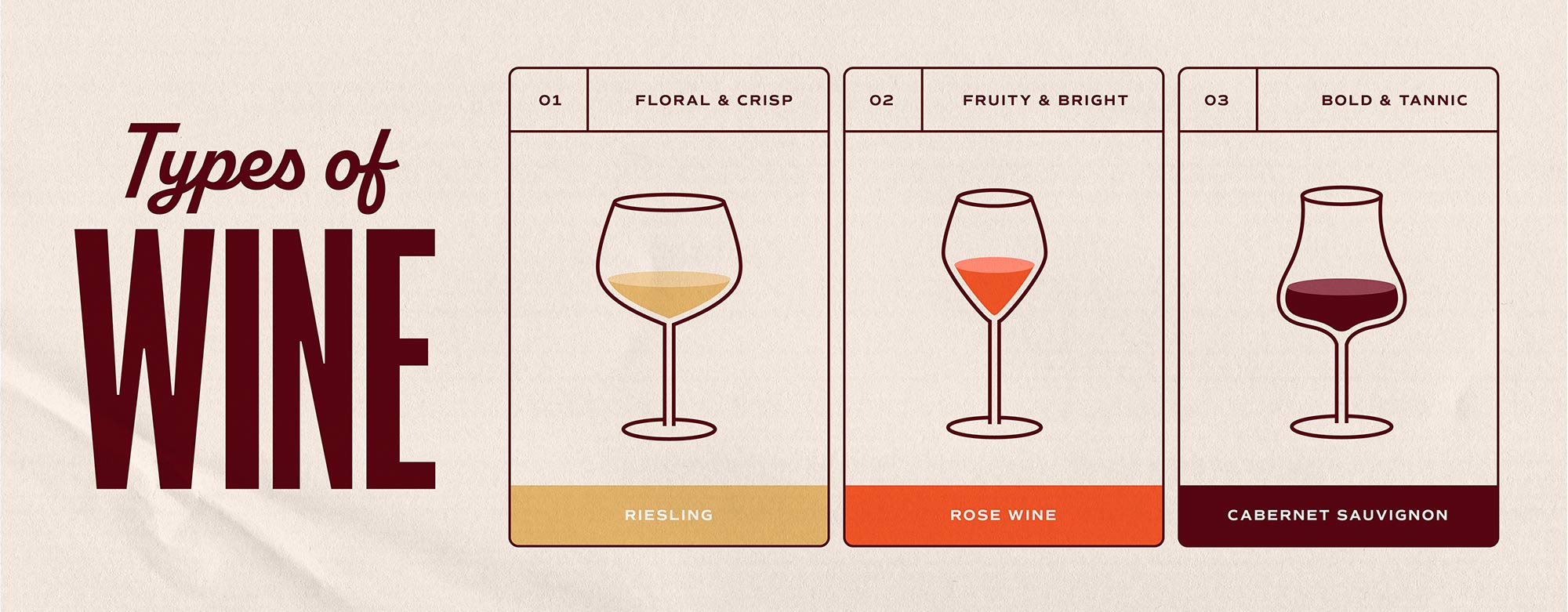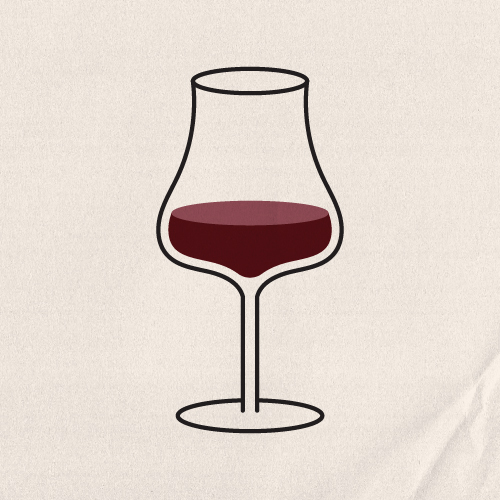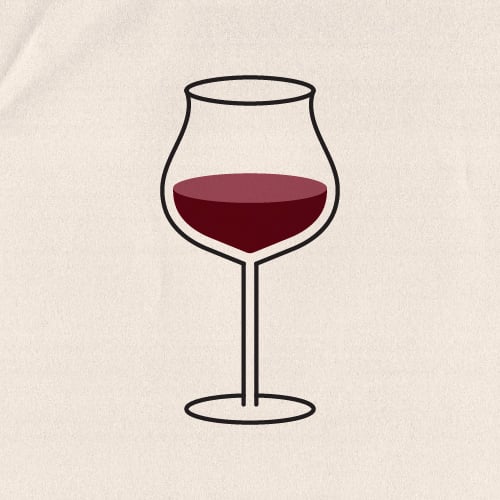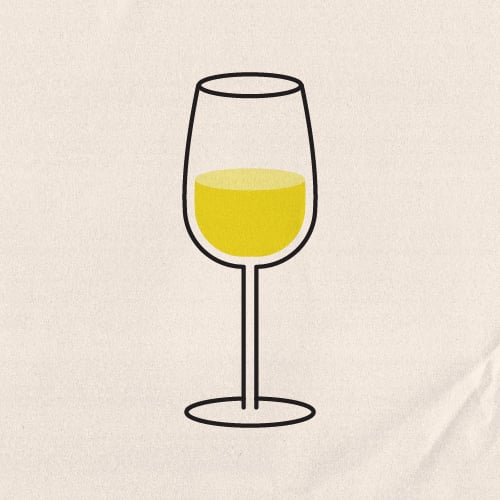
You want to create an elegant wine and cheese pairing, but you may not quite understand the difference between a cabernet sauvignon and a sauvignon blanc. Mastering wine knowledge is no easy feat. There are over a thousand wine varieties to choose from, all grown in countless unique wine regions worldwide. To the aspiring wine connoisseur, this is both exciting and overwhelming. The best place to start is by understanding the nuances of the most popular grapes used to make wine. Wine grapes have seeds, are sweeter than table grapes, and are much smaller than what you see in the grocery store. Even the wines you feel most familiar with have an incredible complexity of flavor and vary widely based on their climate, region, and fermentation process. Our comprehensive guide to the top 10 most popular types of wine will equip your wine service staff to make pairing suggestions and provide educated answers to guests' questions.
Types of Wine
If you’re developing a wine list, you must lay the foundation with the classics. From full-bodied reds to crisp whites, we provide a list of the top 10 most popular wines. We’ll teach you where the wine grapes are grown, as well as their dominant flavors, how to serve them, and how to pair them.
1. Cabernet Sauvignon

Cabernet sauvignon, pronounced cab-er-nay-saw-vin-yawn, is a full-bodied red wine originating from France. Its flavor profile is dry with medium-high tannins and acidity, with an average ABV (alcohol by volume) of 13.5 to 15%. Its high tannin content acts as a palette cleanser when paired with rich, fatty proteins, and its full body complements flavorful dishes and sauces. Cabernet sauvignon grapes appeared in Bordeaux in the mid-1600s as a natural cross between cabernet franc and sauvignon blanc. They blend most of the cabernet sauvignon grapes grown in Bordeaux with other wine grapes (popularly merlot) into the world-renowned Bordeaux blend.
Today, cabernet sauvignon is the most planted wine grape worldwide. While it flourishes everywhere from the Americas to Asia, the top three producers of cabernet sauvignon are France, Chile, and the USA. There are regional differences between cabernet sauvignon grapes grown in warmer and cooler climates. Warm climates produce cabernet sauvignon with strong black fruit, black pepper, and cocoa powder flavors. These grapes typically yield higher ABV wines with ripe-tasting tannin qualities. Cabernet sauvignon grapes grown in cooler climates exhibit red fruit, mint, and green peppercorn flavors. The wines they produce typically have a lighter body compared to their warm-climate counterparts.
- Profile: Dry, Full-Bodied, Medium-High Tannins, Medium Acidity, Medium-High ABV
- Dominant Flavors: Black Cherry, Black Current, Baking Spices, Graphite, Cedar
- Origin: France
- How to Serve: Serve cabernet sauvignon between 60 and 68 degrees Fahrenheit in an oversized wine glass after decanting for 1 hour.
- Pairing Suggestion: Short Ribs or Moroccan Lamb Tagine with Butternut Squash
2. Moscato

Moscato, pronounced moe-ska-toe, is the Italian name for one of the oldest wine grapes, muscat blanc. There are three main styles of wine made from muscat blanc grapes, the most popular are the sweet and semi-sparkling wine known as Moscato d’Asti and the sparkling wine Asti Spumante, both of which are from Italy and have Italy’s DOCG classification, providing a guarantee of origin. Several regions produce dessert moscato wines that contain over 200g/L of residual sugar and have a viscosity that mirrors hot maple syrup. Dry and aromatic muscat blanc wines are traditionally produced in Germany, Alsace, France, and Alto Adige, Italy. While muscat blanc grapes originated in ancient Greece and Italy, they're now primarily cultivated in Italy and France.
Muscat blanc wine grapes produce fruit-forward wines with dominant flavors of citrus like Meyer lemon and mandarin orange accompanied by a trio of pear, orange blossom, and honeysuckle. Their alcohol content is low, usually around 5.5% ABV. Moscato wines are best served cold, but the best glass depends on the style of the wine. Muscat blanc wines are sweet, light-bodied, and typically contain bubbles. Still moscato wines are made with both muscat blanc grapes and other muscat varieties such as muscat Alexandria. Moscato wines pair wonderfully with spicy foods and Asian foods because their low alcohol levels and high sweetness complement heat and aromatics. For proteins, it does well with lighter meats like chicken, turkey, shellfish, and flaky white fish. Moscato pairs well with medium to firm cheeses made from either cow’s or sheep’s milk.
- Profile: Fruit-Forward, Low-Alcohol, Low Acid, Low Body, and Sweet
- Dominant Flavors: Myer Lemon, Mandarin Orange, Pear, Orange Blossom, Honeysuckle
- Origin: Ancient Greece and Italy
- How to Serve: Serve moscato between 45 and 55 degrees Fahrenheit in a sparkling wine, white wine, or dessert wine glass depending on the style.
- Pairing Suggestion: Sushi or Spicy Maple Glazed Turkey
3. Rose Wine

Rose wine, pronounced rose-aye, isn’t defined by a certain type of grape but by how it’s made. It’s produced by fermenting grape juice with its skins for a short period, and then separating the wine from the skins before its color turns deep red. The rest of the fermentation process is completed without the skins by briefly leaving it to settle and stabilize in cool storage tanks before being clarified, bottled, and released. Nearly every grape variety is used to make rose-style wine. Rose is a fruit-forward wine with dominant flavors of strawberry, honeydew melon, rose petal, celery, and orange peel. Typically dry, rose wines have an average body, acidity, and alcohol content. Serving rose wine in an aroma collector glass helps capture its subtle floral notes that are hard to detect when it’s served out of a regular white wine glass. Always serve rose cold. Pair it with delicate and nutty cheeses, white meats, root vegetables, fresh and resinous herbs, and alliums (garlic, onion, shallot).
While its origins are unknown, almost every major country produces rose wine. The top four producers in descending order are France, Italy, USA, and Spain. French rose wines are dry and typically contain a blend of grenache and syrah wine grapes. They’re usually sourced from Provence and Languedoc-Roussillon. In Italy, rose is called rosato and is produced all over the country using several varieties of indigenous wine grapes. Most zinfandel grapes produced in the USA go toward making white zinfandel, a type of rose wine that balances off-dry and sweet flavor profiles. While white zinfandel is the most common type of American-made rose, many new styles are introduced each year. The two most popular types of Spanish rose are made from the meaty tempranillo wine grapes and the brilliant ruby-hued Garnacha which deliver candied grapefruit flavors.
- Profile: Average Body, Fruit-Forward, Average Acidity, Dry, Average Alcohol Content
- Dominant Flavors: Strawberry, Honeydew Melon, Rose Petals, Celery, Orange Peel
- Origin: Unknown
- How to Serve: Serve rose between 45 and 55 degrees Fahrenheit in an aroma collector glass.
- Pairing Suggestion: Burrata Salad with Fig and Crispy Prosciutto or a Charcuterie Board
4. Pinot Noir

Pinot noir, pronounced pee-no nwar, is the most highly prized wine grape in the world. Originating from Burgundy, France, its two largest producers are now France and the USA. Typically, the dominant flavors of pinot noir are cranberry, cherry, and raspberry. Clove and mushroom essences add complexity to its flavor profile. Pinot noir has an average body and alcohol content, medium-high acidity, and medium-low tannins. Its flavor and aroma shine when served at cellar temperature in an aroma collector glass after decanting for 30 minutes. Pinot noir is one of the most universal pairing wines because it’s light enough to pair with seafood and complex enough to complement rich game meats.
There are three primary styles of pinot noir wine: rose, light red, and sparkling. Rose made from pinot noir is zesty and provides the flavors of elderflower, green strawberry, and sour plum. While multiple types of sparkling wines contain pinot noir grapes, the Cremant d’Alsace rose is 100% pinot noir. The flavor of light red pinot noir varies greatly by region, vintage, and producer. Pinot noir from California, Central Otago, NZ, South Australia, Chile, and Argentina delivers flavors of raspberry and clove. Cranberry and mushroom essences are common in pinot noir made in France, Germany, Italy, and Oregon.
- Profile: Strong Fruit-Flavors, Average Body, Average Alcohol Content, Medium-High Acidity, Medium-Low Tannins
- Dominant Flavors: Cranberry, Cherry, Raspberry, Clove, Mushroom
- Origin: Burgundy, France
- How to Serve: Serve pinot noir between 55 and 60 degrees Fahrenheit in an aroma collector glass after decanting for 30 minutes.
- Pairing Suggestion: Sauteed Duck Breasts with Wild Mushrooms or Burnt Ends
5. Pinot Grigio

Pinot grigio, pronounced pee-no gree-jo, is a light-bodied white wine with a refreshing flavor. It’s one of four common types of pinot grapes alongside pinot blanc, pinot noir, and pinot meunier. It has a gray-purple skin and is used to make white and rose wine. Its dominant flavors are lemon, yellow apple, melon, nectarine, and peach. Despite this, it isn’t considered a fruit-forward wine. It’s light-bodied and dry with average acidity and alcohol content. Originally from France and Italy, the three largest modern producers are Italy, the USA, and Germany. Enjoy pinot grigio ice cold in a white wine glass. Pair it with a flaky fish dish, shellfish, and softer cow’s milk cheeses.
Pinot grigio, also known as pinot gris, has three common styles. The style from Northern Italy that we most associate with this wine grape is minerally and dry with citrus notes and salinity. American, Australian, and other warm weathered climates typically produce pinot grigio that is fruity and dry. Sweet and fruity pinot grigio is typically made in Alsace, France, and is imbued with flavors of peach, lemon, and honey. The Friuli-Venezia Giulia region of Italy produces a unique style of pinot grigio called ramato that is used to make a pale-copper-colored rose.
- Profile: Light Fruit Flavors, Light Body, Dry, Average Acidity, Average Alcohol Content
- Dominant Flavors: Lemon, Yellow Apple, Melon, Nectarine, Peach
- Origin: France and Italy
- How to Serve: Serve pinot grigio between 45 and 50 degrees Fahrenheit in a white wine glass.
- Pairing Suggestion: Moules Frites or King Crab Legs
6. Chardonnay

Chardonnay, pronounced shar-dun-nay, is the world’s most planted white grape. Chardonnay wines are full-bodied and fruit-forward with dominant flavors of yellow apple, starfruit, pineapple, butter, and chalk. It has medium-low dryness, average acidity, and medium-high alcohol content. Chardonnay grapes were first grown in France. The top four producers today in descending order are France, the USA, Australia, and Italy. While typically served cold, try serving a rich, creamy chardonnay at 55 degrees Fahrenheit, because slightly warming chardonnay releases its aroma into the bowl of the wineglass. Chardonnays are so versatile you can pair them with almost anything, but they’re popularly paired with creamy sauces, starchy vegetables, and different varieties of oysters.
Chardonnay is one of the few grapes that can grow in a wide range of temperatures, but the climate where it's grown highly affects its flavor. Cooler climates will produce chardonnay with more quince and starfruit flavors. Warmer climates typically produce chardonnay with bolder pineapple and yellow apple essences. Sparkling wines labeled “Blanc de Blancs” are made with chardonnay. Chardonnay comes in three popular styles: oaked, unoaked, and sparkling. Oakey, creamy, and rich chardonnay wines are cultivated in California, Chile, Australia, Argentina, Spain, and Cote de Beaune, Burgundy. Steel-barrel aged, light, and zesty chardonnay are produced in Western Australia, and the Maconnais and Chablis regions of France.
- Profile: Fruit Forward, Medium-Full Body, Dry, Medium Acidity, Medium-High Alcohol
- Dominant Flavors: Lemon, Yellow Apple, Melon, Nectarine, Peach
- Origin: France
- How to Serve: Serve sparkling Chardonnay between 38 and 45 degrees Fahrenheit, Chablis around 45 degrees Fahrenheit, and oak-aged styles around 55 degrees Fahrenheit in a white wine glass.
- Pairing Suggestion: Oysters or Panzanella Salad
7. Sauvignon Blanc

Sauvignon blanc, pronounced saw-vin-yawn blonk, is a light-bodied white wine from France. France remains the largest producer of sauvignon blanc wine grapes, but it is now grown worldwide. It is known for its green, herbal flavors and essences of gooseberries, green melon, grapefruit, white peach, and passion fruit. While it has very little body, it makes up for it with a striking sour tang imparted by its strong acidity. Sauvignon blanc has a medium-low dryness and its alcohol content is average. It’s served ice cold in a white wine glass. Sauvignon blanc pairs wonderfully with herby sauces whether that be Italian pesto sauce or Asian basil stir fry. For cheese, it is an excellent complement to soft, flavorful options like feta, goat cheese, and Camembert.
To preserve its herbal, zesty flavor sauvignon blanc is usually aged in steel tanks. Robert Mondavi made barrel-aged sauvignon blanc famous in the 1970s when he renamed it fume blanc. When it’s barrel-aged, sauvignon blanc has a creamy flavor while retaining the green, herbal notes that it’s known for. The terrior of its growing region also affects the flavor of the wine. Sauvignon blanc wine grapes grown in cooler climates like the Loire Valley in France will exhibit lime flavors. The same grapes, when grown in warmer climates like the northern coast of California, offer flavors of white peach. New Zealand sauvignon blanc is prized for its passion fruit flavor. When grown in moderate climates, it exhibits stronger gooseberry and melon flavors.
- Profile: Herbal, Very Light Body, Very Sour, Dry, Average Alcohol
- Dominant Flavors: Lemon, Yellow Apple, Melon, Nectarine, Peach
- Origin: France
- How to Serve: Serve sauvignon blanc between 45 and 55 degrees Fahrenheit in a white wine glass.
- Pairing Suggestion: Pesto Gnocchi or Thai Basil Tomato Stir Fry
8. Riesling

Riesling, pronounced REESE-ling, is an aromatic white wine prized for its heavily perfumed and sweet aroma. It’s a fruit-forward wine with dominant flavors of lime, green apple, beeswax, jasmine, and petroleum. Riesling’s acidity levels are on par with lemonade, and it has little body. It can either be dry or sweet, and the sweeter varieties contain even less alcohol than their drier counterparts. It’s served fridge cold in a white wine glass. Thanks to its acidity and sweetness, riesling pairs wonderfully with spicy foods like those found in Indian and Asian cuisine. For a cheese pairing, delicately flavored and soft cow’s milk cheese pairs well with riesling.
Riesling originated in Germany, and Germany remains the top producer, and its riesling is considered the best in the world. German riesling wines range from very sweet to dry, so they have different labels to designate their sweetness. Rieslings labeled Trockenbeerenauslese (TBA) or Beerenauslese (BA) are very sweet. Auslese and Spatlese range from medium sweet to sweet. Kabinett and Halbtrocken are off-dry. Feinherb and Trocken are dry. In the USA, Washington State and New York produce dry and sweet riesling. Clare and Eden Valley in Australia produce dry riesling that has an aroma of lime and petrol. French riesling from Alsace is usually dry.
- Profile: Fruit-Forward, Very Light Body, Off-Dry, Very Sour, Low Alcohol
- Dominant Flavors: Lime, Green Apple, Beeswax, Jasmine, Petroleum
- Origin: Germany
- How to Serve: Serve riesling fridge cold (43 degrees Fahrenheit) in a white wine glass.
- Pairing Suggestion: Tikka Masala or Thai Green Curry
9. Port Wine

Port is a sweet, fortified dessert wine from Douro, Portugal made from a unique blend of Portuguese indigenous grapes. All Port wines are still made in Portugal to this day. Fortified wines are preserved with additional spirits before all the grape sugar ferments; the addition of the high-alcohol spirit stops the fermentation process. Port is usually fortified with aguardiente, a type of brandy. Due to its intoxicating sweetness and alcohol contents, 3 oz. is considered a standard serving of Port wine, and it’s served in petite Port wine glasses at room temperature. It’s typically paired with rich, flavorful cheeses, sweets like chocolates and caramels, and salty or smokey nuts. Port is often used in cooking as a decadent ingredient in chocolate cakes and sauces, or chefs simmer it into a reduction sauce and drizzle it over steaks and other savory dishes.
Port’s dominant flavors are ripe blackberry, raspberry sauce, cinnamon, candy apple, and star anise. It is full-bodied, very astringent, highly alcoholic, and has an average acidity. While there are many categories of Port, most fall into one of four styles: ruby, white, rose, or tawny. Ruby-style Port includes LBV (late bottled vintages) and delivers strong red fruit and chocolate flavors accented by a spicy acidity. White-style Ports are made with white grapes indigenous to Portugal and offer flavors of dried peaches, tangerine zest, white pepper, and incense. Rose-style Ports use the rose fermentation process and deliver notes of honey, strawberry, cinnamon, and framboise liquor. The basic quality version of Port wine will age for over 15 years, and certain Port wines, like Vintage and Crusted Port, age for 30 to 50 years.
- Profile: Fruit Forward, Full Boded, Astringent, Highly Alcoholic, Average Acidity
- Dominant Flavors: Ripe Blackberry, Raspberry Sauce, Cinnamon, Candy Apple, Star Anise
- Origin: Portugal
- How to Serve: Serve around 60 degrees Fahrenheit in a Port wine glass.
- Pairing Suggestion: Chocolate Poached Pear Cake or Ruby Chocolate Truffles
10. Merlot

Merlot, pronounced murr-low, is a dry red wine with dominant flavors of raspberry, black cherry, sugar plum, chocolate, and cedar. It’s often mistaken for cabernet sauvignon in blind tastings because the two wines are closely related, but this sophisticated wine deserves a spotlight of its own. It has a medium-full body, tannins, and fruit flavors. Its alcohol content is medium-high, and it has an average acidity. As a medium-full-bodied red wine, merlot falls into the “food wine” category, prized for its ability to pair well with a wide variety of dishes. It makes an excellent accompaniment to rich red meat meals like short ribs, pizzas, and pasta dishes. Serve merlot at room temperature in an oversized wine glass after decanting it for approximately 30 minutes.
Merlot wine grapes originated in the Bordeaux region of France. France remains the top merlot producer; it is the most planted grape variety in Bordeaux. However, there are now merlot growing regions worldwide. In Italy, merlot is cultivated in Tuscany, Veneto, and Friuli-Venezia Giulia. American merlot regions include Washington State and California’s Sonoma and Napa Valleys. Both South and Western Australia cultivate merlot, as does South Africa. The terroir and climate of the region affect the flavor of the merlot it produces. Merlot grown in cool climates produces red currant and red plum flavors, and warmer climates yield flavors of sugarplum and berry jam.
- Profile: Medium-Full Body, Average Acidity, Astringent, Medium-High Alcohol
- Dominant Flavors: Raspberry, Black Cherry, Sugar Plum, Chocolate, Cedar
- Origin: Bordeaux, France
- How to Serve: Serve merlot at room temperature in an oversized wine glass.
- Pairing Suggestion: Filet Mignon and Root Vegetable Chips or Chimichurri and Steak Flatbread
Whether you’re interested in the differences between merlot and cabernet sauvignon, or you want to know how sweet riesling is, our guide to the most popular types of wine answers your questions. Use it as a reference as you explore different regional varieties of these wines. Offer nuanced knowledge of your customers tried and true classics that give them a deeper appreciation for the wines you’re serving.





